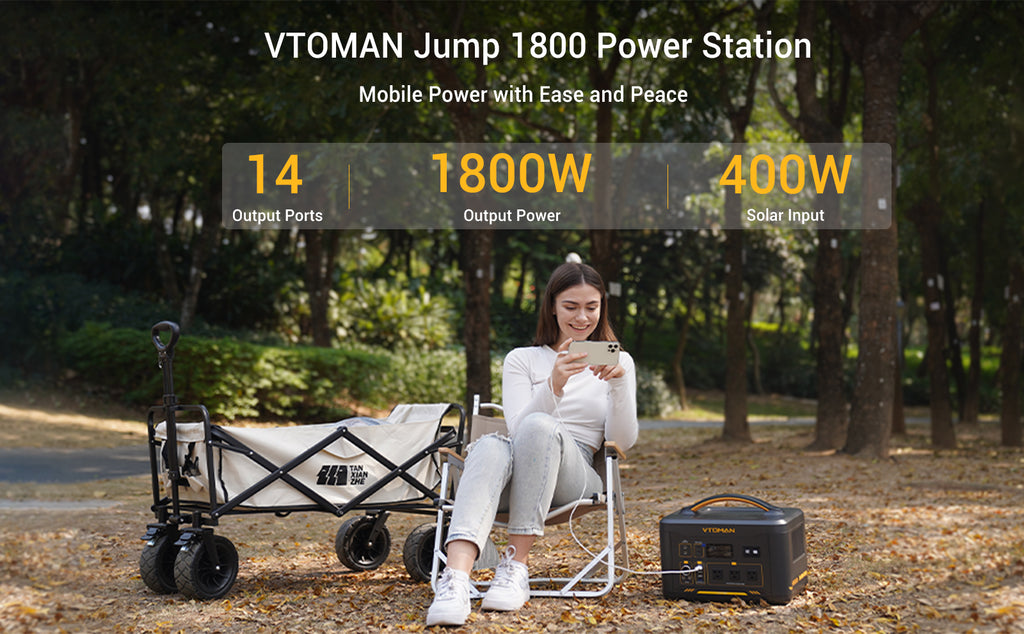Yes, a portable power station, like the VTOMAN Jump 1800, can run a sump pump. It offers a robust 1800W AC pure sine wave output and a large initial capacity of 1548Wh, expandable to 3096Wh, making it capable of handling the high starting and continuous wattage requirements of most residential sump pumps. With additional features such as multiple charging ports and advanced battery technology, the VTOMAN Jump 1800 ensures that it can keep your sump pump running efficiently during power outages, securing your basement against flooding.
For more information about a sump pump and its best "power" partner, please read on.What Is a Sump Pump & How Does It Work?
A sump pump is a pumping system used to remove accumulated water from a sump basin, commonly found in the basements of homes. The pump is triggered by a float switch, which activates as water levels rise, thereby preventing basement flooding and mitigating moisture that could lead to mold and structural damage. The system relies on electricity to operate, making it vulnerable during power outages unless an alternative power source is available.
How to know the real wattage of a sump pump?
1. Check the Manufacturer's Specifications
The easiest way to find the wattage of your sump pump is to look at the manufacturer's label on the unit or consult the user manual. These resources typically list both the running wattage and the peak or starting wattage. This information can also often be found on the manufacturer's website under the product specifications section.
2. Use a Watt Meter
A more precise way to measure the real wattage of your sump pump is to use a watt meter. These devices are plugged in between your sump pump plug and the power outlet. A watt meter will display the exact amount of power the pump consumes in real-time, which includes the starting surge and the running wattage. This method is particularly useful because it provides a direct measurement of power usage under actual operating conditions.
3. Calculate from Amperage and Voltage
If the wattage is not directly listed, you can calculate it using the amperage and voltage specifications, typically found on the pump's label. The formula to calculate wattage is:
Wattage=Amperage×VoltageFor instance, if a sump pump operates at 115 volts and draws 10 amps:
Wattage=10amps×115volts=1150watts4. Refer to General Guidelines
If specific information is not available, general guidelines, about which we will discuss shortly afterward, can provide an estimate based on the type and size of the pump.
What's the Average Wattage of a Sump Pump?
Sump pumps vary in wattage based on their size and the volume of water they need to move. Typically, a residential sump pump requires between 750 and 1,500 watts of power to operate effectively.
Wattages By Sump Pump Type
- Pedestal Sump Pumps: These pumps, which stand upright and are more accessible for maintenance, generally have lower power requirements, around 500 to 1,000 watts.
- Submersible Sump Pumps: Designed to operate underwater in the sump pit, these pumps are more powerful and, consequently, consume more electricity, typically 1,000 to 1,500 watts.
How To Calculate Sump Pump Power Consumption?
1. Identify the Running and Starting Wattage
The first step is to determine both the running wattage (the normal operation power requirement) and the starting wattage (the peak power requirement at startup). You can usually find these figures in the pump's user manual or on its specification label.
2. Calculate Energy Needs
Once you have the wattage, the next step is to calculate how much energy the pump consumes over a period of time, typically measured in kilowatt-hours (kWh). This is calculated by multiplying the running wattage by the hours of operation and then dividing by 1,000 to convert watts to kilowatts.
For example, if your sump pump runs at 800 watts and operates for 3 hours during a storm:
Energy Consumption=800watts×3hours÷1000=2.4kWh3. Account for Cycling
Sump pumps typically cycle on and off rather than run continuously. To estimate cycling, you might assume the pump runs for 10 minutes every hour during heavy rain. Thus, in a 24-hour period, it would run for 4 hours:
Daily Consumption=800watts×4hours÷1000=3.2kWhWhat Size Portable Power Station Do I Need To Run A Sump Pump?
To determine the appropriate size of a portable power station to run a sump pump, you must consider both the starting and running wattage of the pump. Sump pumps often require up to three times their running wattage to start up. Therefore, a power station should have a peak output that can handle at least this initial surge. For a pump that operates at 1,000 watts, for instance, a power station capable of delivering at least 3,000 watts of peak power is advisable.
How Long Will a Portable Power Station Run A Sump Pump?
The duration for which a portable power station can run a sump pump depends on the station's capacity, measured in watt-hours (Wh), and the pump's power consumption. For example, a 1,000-watt pump running on a 2,000-power station under continuous operation would theoretically last for approximately two hours. However, because sump pumps cycle on and off, the actual runtime will be extended.
Best Portable Power Station for a Sump Pump
When selecting the best portable power station for a sump pump, consider the following criteria:
- Capacity: Must be sufficient to handle the pump's start-up and running wattage.
- Battery Life: Look for a unit with a high-quality, durable battery.
- Portability: Although size may be less critical in a stationary home setup, ease of moving and storing the unit can be beneficial.
- Extra Features: Units with additional outputs, solar charging capabilities, and display monitors provide enhanced functionality.

So, what Is the best portable power station for a sump pump?
VTOMAN Jump 1800.

This portable power station is not only robust with an 1800W AC pure sine wave output but also boasts a substantial initial capacity of 1548Wh, which can be expanded up to 3096Wh. This significant capacity ensures that it can efficiently handle the high starting wattage and continuous running requirements of most residential sump pumps.
The VTOMAN Jump 1800 is designed to offer exceptional versatility and durability. It features 12 outlets, allowing for simultaneous charging of multiple devices, making it highly practical in emergency situations where various tools or devices need power. Additionally, the unit incorporates a LiFePO4 battery known for its longevity, supporting over 3100 life cycles up to 80% capacity, ensuring that it remains a reliable part of your home's emergency preparedness kit for years to come.
Safety and functionality are paramount with the VTOMAN Jump 1800. It offers three convenient input modes-wall, solar, and car charging-providing flexibility in how you recharge it. The power station includes advanced features like the V-Starting, capable of jump-starting up to a 9L gasoline or 7L diesel vehicle, and the V-Beyond technology, which handles peak power demands up to 3600W, making it ideal for powering sump pumps that may exceed typical wattages during initial start-up. This blend of power, safety, and cost-effectiveness makes the VTOMAN Jump 1800 a top recommendation for homeowners looking to secure their basements against flooding.
The End
In conclusion, a portable power station can indeed run a sump pump, provided it is adequately sized for the pump's power demands. By ensuring that the power station can handle the wattage requirements of your sump pump, you can keep your basement dry and protected during power outages, securing your home against the elements. This setup not only offers peace of mind but also a practical solution in emergency situations.












